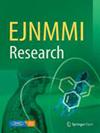线粒体复合体 I 密度与认知健康成年人的智商和认知能力有关:体内 [18F]BCPP-EF PET 研究
IF 3.1
3区 医学
Q1 RADIOLOGY, NUCLEAR MEDICINE & MEDICAL IMAGING
引用次数: 0
摘要
线粒体功能在调节神经传递方面发挥着关键作用,并可能有助于提高智力。线粒体复合物 I(MC-I)是呼吸链中最大的酶。最近,我们利用一种新型正电子发射断层扫描示踪剂[18F]BCPP-EF,测量了MC-I在体内的分布情况。我们以象素为单位进行了分析,发现前中央回和顶叶的[18F]BCPP-EF DVRCS-1与WAIS-IV预测智商、WAIS-IV算术和WAIS-IV符号-数字替换得分之间存在显著关联(象素为单位的皮尔逊相关系数转换为Z-分数,阈值为Z=2.3,P<0.05时进行家族性聚类校正,n=16)。算术分数与额叶中部和中央后回示踪剂摄取量相关,符号-数字替换分数与中央前回示踪剂摄取量相关。RAVLT识别得分与额叶中回、中央后回、枕叶和顶叶区域的[18F]BCPP-EF DVRCS-1相关(n = 20)。综上所述,我们的研究结果支持线粒体功能可能有助于提高一般智力的理论,并表明 MC-I 的个体间差异应成为认知障碍情况下线粒体功能障碍研究的主要考虑因素。本文章由计算机程序翻译,如有差异,请以英文原文为准。
Mitochondrial complex I density is associated with IQ and cognition in cognitively healthy adults: an in vivo [18F]BCPP-EF PET study
Mitochondrial function plays a key role in regulating neurotransmission and may contribute to general intelligence. Mitochondrial complex I (MC-I) is the largest enzyme of the respiratory chain. Recently, it has become possible to measure MC-I distribution in vivo, using a novel positron emission tomography tracer [18F]BCPP-EF, thus, we set out to investigate the association between MC-I distribution and measures of cognitive function in the living healthy brain. Analyses were performed in a voxel-wise manner and identified significant associations between [18F]BCPP-EF DVRCS−1 in the precentral gyrus and parietal lobes and WAIS-IV predicted IQ, WAIS-IV arithmetic and WAIS-IV symbol-digit substitution scores (voxel-wise Pearson’s correlation coefficients transformed to Z-scores, thresholded at Z = 2.3 family-wise cluster correction at p < 0.05, n = 16). Arithmetic scores were associated with middle frontal and post-central gyri tracer uptake, symbol-digit substitution scores were associated with precentral gyrus tracer uptake. RAVLT recognition scores were associated with [18F]BCPP-EF DVRCS−1 in the middle frontal gyrus, post-central gyrus, occipital and parietal regions (n = 20). Taken together, our findings support the theory that mitochondrial function may contribute to general intelligence and indicate that interindividual differences in MC-I should be a key consideration for research into mitochondrial dysfunction in conditions with cognitive impairment.
求助全文
通过发布文献求助,成功后即可免费获取论文全文。
去求助
来源期刊

EJNMMI Research
RADIOLOGY, NUCLEAR MEDICINE & MEDICAL IMAGING&nb-
CiteScore
5.90
自引率
3.10%
发文量
72
审稿时长
13 weeks
期刊介绍:
EJNMMI Research publishes new basic, translational and clinical research in the field of nuclear medicine and molecular imaging. Regular features include original research articles, rapid communication of preliminary data on innovative research, interesting case reports, editorials, and letters to the editor. Educational articles on basic sciences, fundamental aspects and controversy related to pre-clinical and clinical research or ethical aspects of research are also welcome. Timely reviews provide updates on current applications, issues in imaging research and translational aspects of nuclear medicine and molecular imaging technologies.
The main emphasis is placed on the development of targeted imaging with radiopharmaceuticals within the broader context of molecular probes to enhance understanding and characterisation of the complex biological processes underlying disease and to develop, test and guide new treatment modalities, including radionuclide therapy.
 求助内容:
求助内容: 应助结果提醒方式:
应助结果提醒方式:


